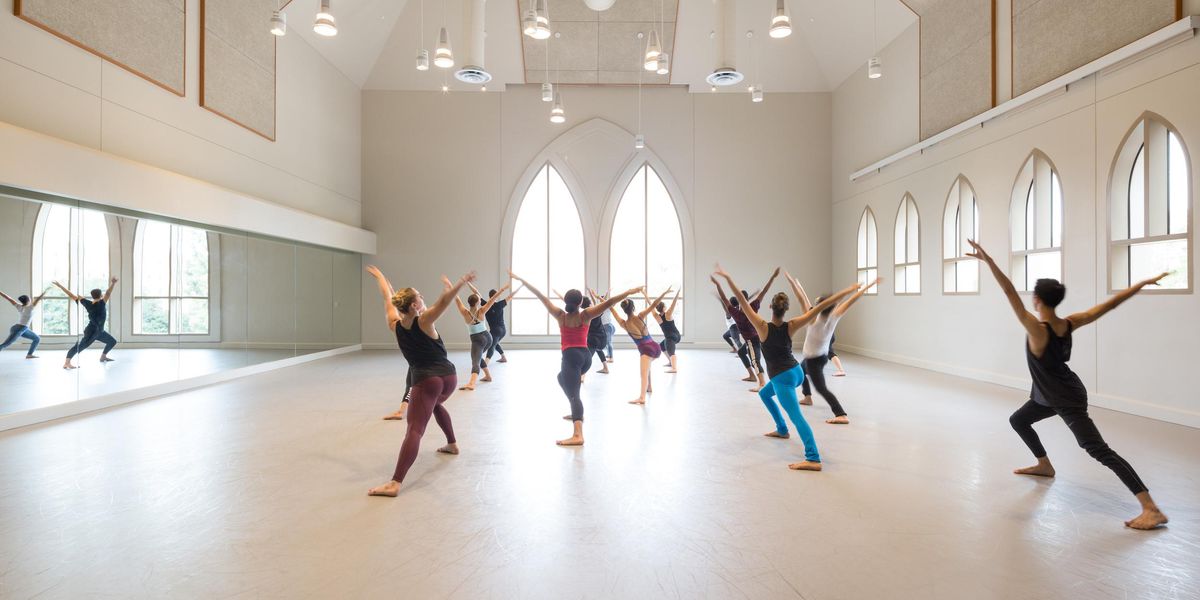Good Work Comes from All Types of Colleges
It’s pleasantly shocking to see the choreographic diversity pouring out of colleges and universities. And it’s not just the better-known dance departments that are producing daring, well-crafted work, but also many community colleges.
As an adjudicator for the West regional conference of the American College Dance Festival Association, hosted by Arizona State University last week, I saw 47 dances performed by students from 27 schools, mostly in California and Arizona. Many of them were created with great skill and performed with real commitment. For my fellow adjudicators (David Shimotakahara, artistic director of GroundWorks in Cleveland, and Rachael Leonard, director of Surfscape Contemporary Dance Theatre near Orlando) and me, it was hard to narrow our choices down to 12 excellent pieces for the Saturday-night gala.
(At right: Students celebrating at the post-gala party in the plaza outside the ASU theater.)
The high level of work reflected not only the students’ abilities, but also faculty guidance behind the scenes. And of course many of the pieces were made by faculty or guest artists. In some cases the performances were so mature that I could hardly believe they were done by students. (Needless to say, the graduate students were more likely to rise to this level.)
Because this is a national year, we also voted on three of the 12 final works to go to Washington, DC, in June.
We saw quite a range of styles and approaches.
There were exhilarating “pure dance” pieces, like Disappearing Days by Eric Handman, who teaches at the University of Utah. It sent four audacious dancers slithering into each other’s negative spaces. They twisted and expanded and collapsed and entwined with a stealth quality—like the way a cat pounces with no preparation.
University of Utah’s Scotty Hardwig and Madeline Hale in Eric Handman’s
Disappearing Days. Photo by Chelsea Rowe.
There was a hilarious spoof of mythology in Neanderthal versus Cyborg from UCLA. As a hippie-like “Neanderthal,” Kevin Williamson drifted stage center while “Cyborg” dashed across the space, dropping a big cluster of cords at his feet. Wearing goggles, coveralls, and a silver cinch-belt, the divine Laurel Tentindo, a Trisha Brown alum who is finishing her grad degree, made a glam Cyborg. The piece escalated from there, with the roguish Cyborg plaguing the gentle Neanderthal with her madcap actions. (Unfortunately, the fact that it exceeded the 12-minute maximum by two seconds disqualified it from the gala. Yikes, ACDFA is strict!)
There was a traditional Bharata Natyam solo choreographed by Viji Prakash and radiantly performed by Rohini Acharya of University of Hawai’i, Manoa.
The Dominican University LINES Ballet BFA program contributed guest artist Robert Sher-Macherndl’s RUSH, a high-octane exercise in Forsythe-like deconstructed tendus, with dancers yelling “Go!” to start a new phrase. The technical feats of these very savvy dancers elicited shrieks and sighs from the audience.
Dominican University LINES Ballet BFA student William Couture in Robert Sher-Macherndl’s
RUSH
There was the very moving first impressions; fragile ground from El Camino College. In this work by faculty member Liz Hoefner Adamis in collaboration with six students, each participant spoke out about the difference between their first impressions of a classmate and what they learned about that person by setting aside those early superficial thoughts. I don’t remember the exact words or movements, but the combination created a real poignancy. The humanistic concept of breaking through façades to form a deeper opinion is a simple idea, but so important that I wished the piece could be performed on the floor of Congress.
From Scottsdale Community College came a gripping hip-hop solo that went beyond a display of tricks to enter a taut, self-questioning state of mind. Student choreographer RaShawn Hart’s Choices of Thought was performed by George Jones, an urban dancer who just started taking ballet and modern classes last year.
From the Dust,
choreographed by Kelsey Peterson, a student at Saint Mary’s College, gave eight women dressed in earthy colors some dynamic pelvic moves. The dancers’ keen commitment to the movement and their support of each other created a strong sense of community.
A rehearsal for From the Dust, choreographed by Saint Mary’s College student by Kelsey Peterson. ASU campus.
I saw lots of deep-in-the-body dancing, dramatic intensity, collaborative spirit, and giddy creativity. But I also saw two weaknesses that kept cropping up. The first was the titles, which sometimes promised too much or were misleading. When you choose a title like When I Die Leave the Balcony Open, your dance had better be as provocative as those words. And it’s frustrating to read a title like Crash when there’s no crashing, or Victim when nobody’s a victim.
The other problem was music choices. It’s easy to search iTunes and find something with a rich sound and a strong beat. But that song may be so textured, nuanced, or complex that it overshadows your dance.
OK, enough carping. I had a ball looking at this treasure trove of student and faculty work. I wish I could go to the Nationals in June and see three of these pieces again, plus the best of the 10 other regions!




